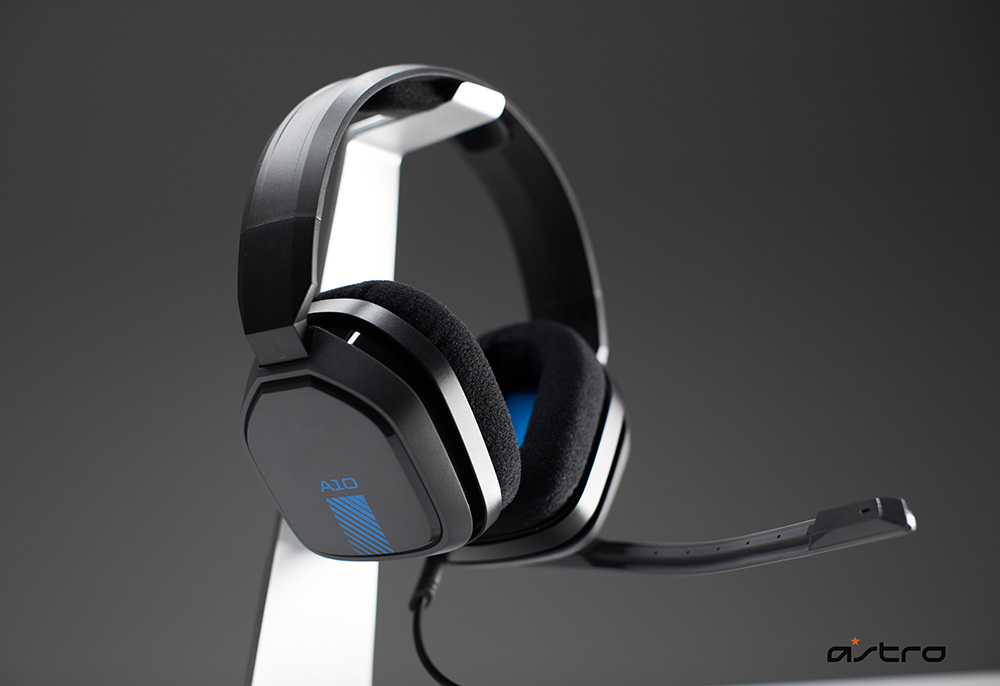The history of Astro Gaming is born out of esports.

“For us, the pinnacle of design is designing for the top one percent of users—the people who are going to use the headset for eight to ten hours a day,” Thaddeus Cooper, director of community at Astro Gaming, told AListDaily while demonstrating its newest headset, the A10. “For them, it’s more like performance enhancing equipment than just wanting to game. The idea is that when you design for the pinnacle, then it’s kind of like when Nike designs shoes for long distance runners and Olympians, they learn about ergonomics, and that makes it into your daily streetwear.”
It was taking into the consideration of pro and high-end gamers that led to the development of the A50 headset by trimming away the pro features that most home users probably don’t need. That philosophy continues with the development of the $60 A10, which priced considerably lower than Astro’s other professional grade headsets that range from $150 to $300.
Cooper has been a part of the A10’s development from the beginning, and he explained how the company is very community-driven, marked by its large social media presence. Astro has over one million followers on YouTube and close to a million followers on Instagram. The company is very active on the social space, and its fans are very engaged and vocal. In fact, they’re enthusiastic enough to fill out lengthy annual surveys that revealed how roughly 80 percent of the people who follow Astro on social media don’t own any of the company’s products.
That led Astro to conclude that there was a large audience that wanted to join the “Astro family,” but couldn’t because the premium price points gated them off. Astro took that as a challenge to design something so that the larger gaming community will have access to its products. To that end, the A10 is being officially revealed today at E3 this week, where it is being shown alongside the A40 and A50 headsets. Afterward, it will be shown at other conventions, including PAX and Gamescom in addition to being featured at listening stations at stores such as Best Buy and Gamestop.
Building A More Inclusive Audience
“We felt that it was time for Astro Gaming to be more accessible to its larger audience base,” said Cooper. “My team, the marketing team, and a few others in the company decided that it was time for us to branch out and do more to have a much more inclusive audience base.”
 However, developing a budget-minded pro-level headset created its own problems within the company. Cooper said that they had to ask themselves, “How do we defend our brand as a premium brand while at the same time giving people a more accessibly priced product?” The answer was to address the four issues that players want most from a gaming headset so that they won’t stick to using the cheap speakers built into their televisions. Those features are comfort, durability, audio quality and compatibility.
However, developing a budget-minded pro-level headset created its own problems within the company. Cooper said that they had to ask themselves, “How do we defend our brand as a premium brand while at the same time giving people a more accessibly priced product?” The answer was to address the four issues that players want most from a gaming headset so that they won’t stick to using the cheap speakers built into their televisions. Those features are comfort, durability, audio quality and compatibility.
Cooper reiterated how Astro is famous for making headsets that people can wear for long periods of time, even with glasses, so it already had the comfort issue covered. The A10s are designed to be worn for six to eight hours by pro gamers during practice, and they’re also made to fit over VR headsets.
Durability was the second most important factor for gamers. Cooper recounted how reviews for headsets that cost under $100 usually complain about how they break within a year or two, forcing them to buy new ones. Cooper explained that Astro designed the A10 so that first-time consumers wouldn’t feel forced to buy an A40 or A50 because it broke.
“We want it to be a choice,” said Cooper. “We want you to say, ‘I bought an A10 and it lasted for two years. It’s great and I love it, but I’m ready for A50. I want wireless and I want to go to the next level in Astro Gaming.’ We wanted to do this right because we wanted to protect our brand.”
Nobody buys a more expensive version of a headset that breaks easily, and Cooper proceeded to demonstrate the A10’s durability by twisting and bending the headband around, far past the point where many budget headsets would break. He also tossed the headset across the room onto the floor to show how it wouldn’t break or lose sound quality.
Astro aimed to have a very similar audio quality experience to that of the A40s. “The reason for that is because we want young players and aspiring pros to take these to an MLG tournament, the same way they can take A40s.” The A10 can also be plugged into Astro’s Mixamps to take advantage of a variety of different features, which ties the headset’s near universal compatibility.
“People don’t want to buy a $100 headset for their Xbox, then have to buy another one for their PlayStation,” Cooper explained. “With the current ecosystem of consoles, we felt it was the perfect time to launch something like this.”
He explained how both Microsoft and PlayStation deliver high-quality audio wirelessly through their respective controllers, and Microsoft in particular launched its Sonic 3D audio platform for free on Windows 10 and will soon bring it to Xbox One. The technology produces 3D sound with headphones that support Dolby sound.
Although the A10 headset comes in three different colors to denote platform (green for Xbox, blue for PlayStation and orange for PC), those distinctions are mainly to fit retail and licensing requirements. All versions work universally using the 3.5mm audio connector, however only the Xbox One version offers an optional bundle that includes a gamepad adapter. The adapter has a set of controls that lets users can change the volume or mute the mic without having to let go of the controller or drop out of a game to adjust settings.

Every Headset Is A Starting Point
Given how the A10 delivers a high level of audio quality, we asked Cooper how Astro would convince users to take their experience to the next level with a more expensive headset like the A50. He maintained that all of Astro’s headsets are designed for a high standard of audio. He then said that changing headsets was “more about your overall experience. The build quality and comfort will be in all headsets, but the A50 will give you a [truly] wireless experience.” The A50 also doesn’t draw power from the controller, and it has a number of other features that the A10 doesn’t, such as 7.1 surround sound and software audio tuning. “There are more quality of life features with the A50,” Cooper explained.
The A10 also has a noticeably different look from Astro’s usual style. For example, it lacks the signature bars that are found on both the A40 and A50 headsets. We asked Cooper how people would recognize the A10 as being part of the Astro family of products.
“Silhouette is one of the most important things we try to design for,” Cooper replied. “We try to make an iconic look with our headsets, and we want everything you wear from Astro Gaming to be recognizable because one of the things people love about a prestige brand is being recognized. So, we feel that in designing this headset, we kept an Astro aesthetic that makes a noticeable silhouette that sets it apart from other headsets. If you look at the way design aesthetic are going right now, a lot of our competitors are trying to create Beats-style headphones with a circular look and could be worn on the street. We went for more of an iconic and tech-driven look for these headsets.”
Just don’t describe the A10 as a starter headset. “The term ‘entry level headset’ gets tossed around a lot, especially at certain price points,” said Cooper. “As a marketer, semantics means a lot to me, so I have a really hard time with the term. I think everyone has their own level that they enter the game at.
“If you come to me as a pro gamer or streamer for a headset recommendation, I’m going to steer you toward an A40 and that would be your entry level headset. If you’re looking for the best wireless experience you can get in your home, then the A50 is going to be the headset for you. If you’re a young gamer trying Astro for the first time, but don’t have $300 to spend on a headset, I’m going to steer you towards the A10. Every headset we make is an entry point into what Astro does. It just depends on what your skillset is and what you need.”
Staying With Core Philosophy
Finally, we asked Cooper if Astro would spend less time focused on the small percentage of high-performance gamers to address the broader audience moving forward.
“Not at all,” replied Cooper. “We’re always going to be focused on designing for that top one percent of users—people who will need features that those playing in their living rooms don’t. As long as we are always focused on the pinnacle use case scenario, and everything we learn can be used in new designs, I don’t think we’ll ever change the philosophy of making pro gaming hardware for enhancing esports, professional gaming, streaming, and audio design. I feel that losing that focus would send us down [the wrong] road, where companies treat their products like commodities, instead of engineering and designing them to solve problems.”

